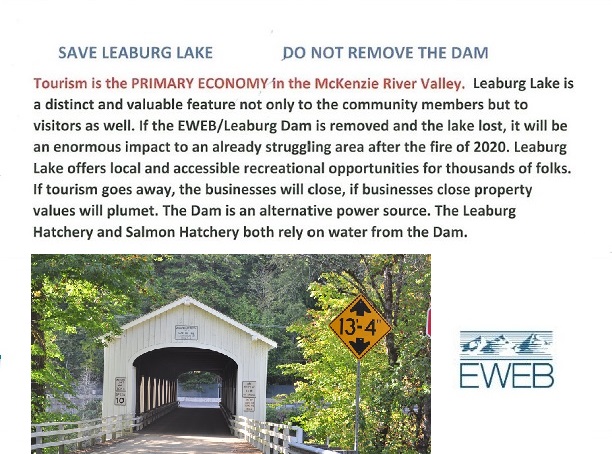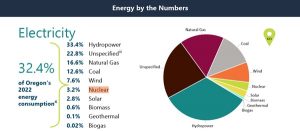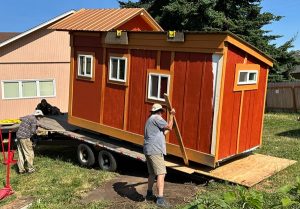Residents ask EWEB to preserve key evacuation route: Leaburg Dam Road
9 min read
Upriver residents ask EWEB to preserve a key evacuation route. At the board meeting August 1:
Jake Risley: My name is Jake Risley. I’m here tonight with my wife and several of my neighbors who live on Leaburg Dam Road, Leashore Drive, and Goodpasture Road. We weren’t supportive of EWEB’s decision to remove the dam. I would bet if you lived or owned a business upriver, you probably would feel the same way.
[00:00:21] But we’re not here to talk about EWEB’s decision to decommission the dam. We’re here to assist you in making your next decisions, ones that will affect all of us that live on these three rural roads: access to our homes, access to our businesses, and access to our park.
[00:00:35] For example, Jim Russell, who owns the Whitewater Ranch, a large organic blueberry farm and timber operation located across Leaburg Dam, currently harvests about 750,000 pounds of blueberries each year and hauls them across the dam to market. EWEB’s proposed route across Goodpasture Bridge would create enormous impact on his operation. His trucks won’t fit under that bridge.
[00:00:58] Increased traffic along this proposed route will also impact the hundreds of residents that live and work on the south side of the McKenzie River by creating safety issues through congestion at the intersection of Goodpasture Road and Highway 126.
[00:01:11] Jim Russell reached out to Adam Spencer and Jeremy Somogye and relayed to me, that EWEB intends to bring on a consultant to assist with the transportation analysis that will look at access alternatives. I’m told this will happen later this year or early next year. We also understand that there will be opportunities for public feedback of your analysis, which I’m sure many of us will want to take part in.
[00:01:32] Adam asked Jim to get back to him with traffic concerns to help him with the analysis. Those of us that live upriver know the obstacles and disruptions that will occur if your proposed route connecting Leaburg Dam to Leashore Drive is chosen. I’ve listed just a few that you may not be aware of.
[00:01:48] First, there’s property owners along this route who are adamant that they won’t sell their land or have a road run through their property. Are you going to have to resort to a condemnation of their property?
[00:01:57] Second, existing topography and exposed bedrock along this route will make it very expensive to construct a two-lane road that meets Lane County standards.
[00:02:06] Third, there’s a private water system for the residents that live along Leashore Drive, a run that runs alongside and under the current road, which would need to be replaced as well as the treatment facility at the corner of Leashore Drive and Goodpasture Road.
[00:02:19] Four, the existing intersection of Goodpasture Road and Highway 126 has poor sightlines in both directions. And traffic across the historic Goodpasture Bridge is limited to a single lane.
[00:02:30] In order to make this intersection safe, ODOT would need to widen the road and create a left-hand-turn lane for left-bound traffic, which would be very costly due to the large rock wall that runs along the north side of Highway 126. These are just a few of the physical challenges that need to be considered when this route is examined. Other impacts include:
[00:02:50] First, widening rural neighborhood roads and changing the livability of existing residents to accommodate increased traffic to Lloyd Knox Park, the McKenzie Fish Hatchery, and Whitewater Ranch.
[00:02:59] Second, lowering of home values along Leaburg Dam Road, Leashore Drive, and Highway 126 by removing Leaburg Lake.
[00:03:06] Third, what will be happening to Lloyd Knox Park? Leaburg Lake is its primary draw. If the lake is removed, who will come and what will they do? We fear the negative impacts they might bring to those of us that live along this proposed route.
[00:03:18] Ben Bowen: My name is Ben Bowen and I have been involved in developing emergency evacuation plans for residents on Goodpasture Road. I’d like to speak to you tonight regarding the LDAP (Leaburg Decommissioning Action Plan) and the future of Leaburg Dam Road. And folks, Goodpasture Road, Leaburg Dam Road are the sole entry and exit portals for their residents.
[00:03:43] The existence of emergency evacuation routes have life or death importance to these residents and therefore should be a key component which is currently missing from the LDAP. If the current LDAP is enacted, all of the residents of both Goodpasture Road and Leaburg Dam Road will have to rely on the wooden Goodpasture Bridge as their sole emergency evacuation portal.
[00:04:12] The risk this plan places on these residents became strikingly evident during the Holiday Farm Fire when the Goodpasture Bridge was only saved through the heroic actions of the McKenzie Fire Department—a result that cannot be guaranteed for future fires.
[00:04:34] Actually, the situation is worse, as the current LDAP significantly increases the risk, specifically for Goodpasture Road residents. It is because Leaburg Dam Road has been identified as a key component of the safest emergency evacuation route for Goodpasture Road residents in case exit across the Goodpasture Bridge is jeopardized.
[00:05:02] Without the Leaburg Dam Road as an exit point, Goodpasture residents would be forced to navigate long stretches of unmarked logging roads in an attempt to reach Highway 58 for safety. Our request, therefore, is that you please include this very important factor in your future planning efforts.
[00:05:25] John Farkas: My name is John Farkas, and I’d like to address the same issue. There’s two communities, Leaburg Dam Community and Goodpasture Road Community.
[00:05:34] Each of these have one thing in common, only one way out. Ben mentioned the (Leaburg) Dam Road is very, very important, far less subject to any adverse problems, such as fire destroying the Goodpasture Bridge.
[00:05:51] I understand that in some previous discussions your committee discussed connecting the two communities who are right now, not connected. They’re neighbors, but they’re not connected.
[00:06:01] If you do that and eliminate the (Leaburg) Dam Road, all the Leaburg community folks will have to also channel the Goodpasture Bridge, to try to get out. It’s going to be like rush hour traffic on an on-ramp going that way, and I saw that already on that famous night, Labor Day, when the fire broke out and we were evacuated at midnight, and there were cars lined up just to get through back to the bridge.
[00:06:34] For the safety of both communities, please find a solution where there are more ways to get both of those communities out onto (Highway) 126.
[00:06:45] The only way right now out of either Leaburg Dam Road or Goodpasture residents is through a treacherous gravel logging road, which goes through gated private property, and even if you get through, it takes you something like 30 miles to connect with Route 58 near Oakridge.
[00:07:08] So please give us some hope that we will be able to evacuate. We have no way of getting out. Especially not if you would put all the Leaburg Dam (Road) residents onto the Goodpasture Bridge Road connecting the two communities.
[00:07:25] Nadine Scott: I’m Nadine Scott, a homeowner on Leaburg Lake, a real estate broker for Windermere Real Estate. I was president of the McKenzie Chamber of Commerce for 12 years. I’m correspondence secretary for the McKenzie ClearWater Coalition and a concerned EWEB ratepayer.
[00:07:43] It’s my understanding to decommission the Leaburg tile canals, remove the EWEB dam bridge and revert Leaburg Lake back to a river, the estimated cost would be about $221 million. And not all expenses have been researched. A recent article in the RG (Register-Guard) said you were going to have to find ways to generate more power.
[00:08:04] You have an existing green energy resource that you’re destroying. And you recently built a substation in Leaburg at the expense of $7.6 million. I’m here tonight to ask why the dam, the bridge be removed and the lake drained. The dam does not produce any power, and EWEB recently spent $5.2 million clearing all three rollgates on the dam.
[00:08:36] I believe EWEB owns the bridge and the dam, but the county owns the road over it and maintains it. It is the only ingress/egress to homes on the other side of the bridge. A road builder told me if he had to build a new bridge and road over the river lake, it would cost around $10 million. If EWEB kept the dam and the bridge and just maintained it, it would be a fraction of the cost of removing it.
[00:09:06] Has EWEB contacted Lane County commissioners to discuss the option of them taking over the existing dam and bridge and maintaining it rather than building all new roads? The cost of them maintaining it would be considerably less than building a new bridge and roads.
[00:09:25] Tourism is the main economy in the McKenzie River Valley. Last September, we gathered 1,100 signatures from tourists that were using Leaburg Lake for recreational purposes. If the lake goes away, so does tourism. If tourism goes away, businesses will be affected. Decreasing business will affect the housing market and the economy of the McKenzie River Valley. We need to preserve what we have instead of destroying historical landmarks and recreational opportunities for our already suffering McKenzie River Valley community after the devastating fire of 2020.
[00:10:07] I wonder if your ratepayers are aware of the extreme increases they will have to absorb for years to come after you have already wasted over 12 million dollars of your ratepayers dollars.
[00:10:22] Gary Hatfield: Gary Hatfield. Look, the reason I’m showing up here is because of, everybody knows, the Leaburg issue, and the dam is coming down and the water is going to flow and we have a group and a core of people up there that are very concerned and upset about various things resolving the dam removal, whether it be a bridge access, or whether it be recreational use, or whether it be just the fact that it’s been there a long time.
[00:10:48] So my testimony basically is to say: Look, in 1967, I had the opportunity of working for the Corps. They put a great value on recreational locations, and If I’m not mistaken, at that time Leaburg was one of the focus areas for the Eugene / Lane County area. I didn’t do the survey up there at Leaburg, but I did it at two or three other areas of recreational usage by folks that came in for lake use. So, you’ve got that, that we need to consider.
[00:11:22] You’ve got, obviously, access to the other side of the river for folks. You’ve got a lot of us doubting the fact that you can’t at least update that facility and make it workable and profitable. To tear something down is expensive, it will also affect a lot of people, and adversely, and you’re affecting so many pieces and parts, all of the costs and expenses—not only emotional expenses—but expenses by people and money and usage of this lake, and that dam. And I just am not convinced, nor do I think are neighbors.
[00:11:56] We don’t know, the size of that river will go down to 20 or 30 feet, we don’t know that. We don’t know why Mr. Brown over here hasn’t—maybe he can give me some light on the recreational usage of the river and the licensed fishermen and people that take people up and down the river, why that would be a good idea for those that do that for a living.
[00:12:19] So in looking at it from a broad standpoint, and with all of us neighbors and what have you, I flew up here for my three minutes to say: This is wrong. And somehow we’re going to do something about it. I don’t know what. It’s certainly not going to be expressing ourselves to you here and getting somebody to make a decision. It probably is going to have to be some wizardry of knowledge that will allow us to do something to stop this.
[00:12:44] Now, one last thing from my vantage point. If I’m not mistaken, you talked about 20 years, is that right, to decommission this and tear it down?
[00:12:54] EWEB General Manager Frank Lawson: Probably a 15-to-20 year process.
[00:12:55] Gary Hatfield: Fifteen to 20 years. Well, when you’re my age…it’s an important thing for me and a lot of other people up there, plus those that come behind me, my family and their families, that we do the best we can while we’re still here to talk about it.
[00:13:08] Will Rutherford: I’m Will Rutherford. I’m a resident of Vida, and I’d like to compliment the people that made the presentations at the June upriver meeting. So you have made a lot of information available to everybody, and I hope that we can use that information as part of our dialogue as we wrestle through challenges of upriver, beaver canal, beaver dam, lake, and all of that. Thank you for what you’re doing, keeping the public informed about processes.
John Q: Upriver residents ask EWEB to preserve a key evacuation route, the Leaburg Dam Road.






